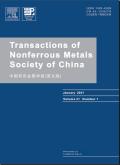通过分子接枝技术改善基于铜铝双金属金属有机框架的固体聚合物电解质的离子电导率
IF 4.7
1区 材料科学
Q1 METALLURGY & METALLURGICAL ENGINEERING
Transactions of Nonferrous Metals Society of China
Pub Date : 2024-09-01
DOI:10.1016/S1003-6326(24)66587-8
引用次数: 0
摘要
通过分子接枝制造了一种由铜铝双金属金属有机框架(CAB)、锂盐(LiTFSI)和聚环氧乙烷(PEO)组成的复合固体电解质,以提高基于 PEO 的电解质的离子电导率。实验和分子动力学模拟结果表明,含 10 wt.% CAB 的电解质(PL-CAB-10%)具有高离子电导率(8.42×10-4 S/cm,60 °C 时)、高锂+转移数(0.46)、宽电化学窗口(4.91 V)、良好的热稳定性和出色的机械性能。此外,PL-CAB-10% 在锂-锂对称电池和锂/PL-CAB-10%/LiFePO4 不对称电池设置中均表现出优异的循环稳定性。这些性能的提高主要归功于多功能 CAB 的引入。CAB 中丰富的金属位点可通过路易斯酸碱相互作用与 TFSI- 和 PEO 发生反应,促进 LiTFSI 解离并提高离子导电性。此外,CAB 中的规则孔隙为循环过程中的阳离子电镀提供了均匀分布的位点。本文章由计算机程序翻译,如有差异,请以英文原文为准。
Improvement of ionic conductivity of solid polymer electrolyte based on Cu−Al bimetallic metal-organic framework fabricated through molecular grafting
A composite solid electrolyte comprising a Cu−Al bimetallic metal-organic framework (CAB), lithium salt (LiTFSI) and polyethylene oxide (PEO) was fabricated through molecular grafting to enhance the ionic conductivity of the PEO-based electrolytes. Experimental and molecular dynamics simulation results indicated that the electrolyte with 10 wt.% CAB (PL-CAB-10%) exhibits high ionic conductivity (8.42×10−4 S/cm at 60 °C), high Li+ transference number (0.46), wide electrochemical window (4.91 V), good thermal stability, and outstanding mechanical properties. Furthermore, PL-CAB-10% exhibits excellent cycle stability in both Li−Li symmetric battery and Li/PL-CAB- 10%/LiFePO4 asymmetric battery setups. These enhanced performances are primarily attributable to the introduction of the versatile CAB. The abundant metal sites in CAB can react with TFSI− and PEO through Lewis acid–base interactions, promoting LiTFSI dissociation and improving ionic conductivity. Additionally, regular pores in CAB provide uniformly distributed sites for cation plating during cycling.
求助全文
通过发布文献求助,成功后即可免费获取论文全文。
去求助
来源期刊
CiteScore
7.40
自引率
17.80%
发文量
8456
审稿时长
3.6 months
期刊介绍:
The Transactions of Nonferrous Metals Society of China (Trans. Nonferrous Met. Soc. China), founded in 1991 and sponsored by The Nonferrous Metals Society of China, is published monthly now and mainly contains reports of original research which reflect the new progresses in the field of nonferrous metals science and technology, including mineral processing, extraction metallurgy, metallic materials and heat treatments, metal working, physical metallurgy, powder metallurgy, with the emphasis on fundamental science. It is the unique preeminent publication in English for scientists, engineers, under/post-graduates on the field of nonferrous metals industry. This journal is covered by many famous abstract/index systems and databases such as SCI Expanded, Ei Compendex Plus, INSPEC, CA, METADEX, AJ and JICST.

 求助内容:
求助内容: 应助结果提醒方式:
应助结果提醒方式:


